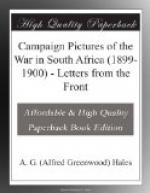Three hundred yards to the rear of the little township of Modder River, just as the sun was sinking in a blaze of African splendour on the evening of Tuesday, the 13th of December, a long, shallow grave lay exposed in the breast of the veldt. To the westward, the broad river, fringed with trees, ran murmuringly, to the eastward, the heights still held by the enemy scowled menacingly, north and south, the veldt undulated peacefully; a few paces to the northward of that grave fifty dead Highlanders lay, dressed as they had fallen on the field of battle; they had followed their chief to the field, and they were to follow him to the grave. How grim and stern those dead men looked as they lay face upward to the sky, with great hands clenched in the last death agony, and brows still knitted with the stern lust of the strife in which they had fallen. The plaids dear to every Highland clan were represented there, and, as I looked, out of the distance came the sound of the pipes; it was the General coming to join his men. There, right under the eyes of the enemy, moved with slow and solemn tread all that remained of the Highland Brigade. In front of them walked-the chaplain, with bared head, dressed in his robes of office, then came the pipers, with their pipes, sixteen in all, and behind them, with arms reversed, moved the Highlanders, dressed in all the regalia of their regiments, and in the midst the dead General, borne by four of his comrades. Out swelled the pipes to the strains of “The Flowers of the Forest,” now ringing proud and high until the soldier’s head went back in haughty defiance, and eyes flashed through tears like sunlight on steel; now sinking to a moaning wail, like a woman mourning for her first-born, until the proud heads dropped forward till they rested on heaving chests, and tears rolled down the wan and scarred faces, and the choking sobs broke through the solemn rhythm of the march of death. Right up to the grave they marched, then broke away in companies, until the General lay in the shallow grave with a Scottish square of armed men around him, only the dead man’s son and a small remnant of his officers stood with the chaplain and the pipers whilst the solemn service of the Church was spoken.




